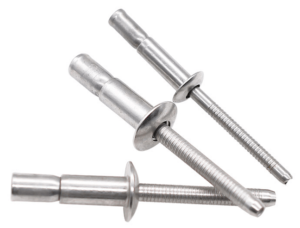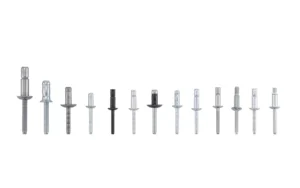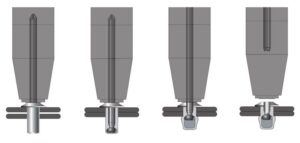Monobolt vs Pop Rivet - The Most Complete Buyer's Guide
Table of Contents
In the manufacturing and assembly fields, blind rivets (Blind Rivet) are widely used due to their quick installation and reliable connection. However, when facing high-strength or waterproof requirements, traditional Pop Rivets have been unable to meet engineering needs. At this point, the Monobolt, which has a mechanical locking structure, becomes a more suitable choice for higher performance. What are the differences between Monobolt and Pop Rivet? In short, Monobolt has higher structural strength, vibration resistance performance and sealing ability, while Pop Rivet is known for its low cost and installation efficiency. This article will conduct an in-depth comparison of the two to help you select the most suitable rivet solution for different applications.
Understanding the Difference: What Are Pop Rivets and Monobolts?

In blind riveting fastening technology, Pop Rivet (standard blind rivets) and Monobolt (structural rivets) are two of the most common types, but with significant performance differences. There are obvious differences between the two in terms of structural design, load-bearing capacity and sealing performance. Therefore, when selecting a model, it is necessary to determine which one is more suitable based on the load requirements and usage environment.
| Type | Structural Features | Application Scope | Key Performance Points |
|---|---|---|---|
| Pop Rivet (Standard Blind Rivet) | Single-layer structure; mandrel breaks and partially remains inside the rivet body | Light sheet metal, electronic devices, furniture assembly | Easy installation, low cost, high assembly efficiency |
| Monobolt (Structural Rivet) | Closed-end design with an internal mechanical locking mechanism (Locking Mechanism) | High-load structures, vehicles, building steel frameworks | High strength, vibration resistance, waterproof, and corrosion resistance |
- Pop Rivet is the most commonly used standard blind rivet form. During installation, the mandrel is broken and remains inside the cap, creating a basic mechanical clamping connection. It is easy to operate and inexpensive, making it an ideal choice for mass production assembly.
- Monobolt belongs to Structural Blind Rivet. Its interior is equipped with a mechanical lock core, which can firmly lock it in the cap after the mandrel breaks, forming higher tensile and shear strength. At the same time, the closed bottom can prevent liquids and gases from penetrating, providing excellent sealing protection.
Structural Difference Between Monobolt and Pop Rivet
Although Monobolt and Pop Rivet belong to the same series of blind rivets, they have fundamental differences in their structural design and force application methods. Understanding this distinction is crucial for selecting the appropriate riveting solution, especially in applications where high requirements are placed on strength, water resistance, and vibration resistance.
① Pop Rivet: Standard structure, achieves locking through expansion
The standard Pop Rivet (open-ended blind rivet) follows the most basic riveting principle. During the riveting process, the mandrel is pulled, causing the tail of the cap body to expand, thereby achieving material clamping. When the mandrel breaks at the preset break point, only a part remains inside the cap body and does not have the locking function. Therefore, this structure is suitable for light-load or non-waterproof assembly scenarios, such as the connection of appliance sheet metal and thin plates. The Pop Rivet belongs to the “single-locking structure”, and under long-term vibration or temperature change, it may experience slight loosening or stress attenuation.

② Monobolt: Mechanical Locking + Secondary Clamping Structure

The Monobolt belongs to the category of Structural Blind Rivet. Its core innovation lies in the Locking Mechanism of the locking core. When the core shaft is pulled out, the tail end of the cap body not only expands to clamp the material but also triggers the internal locking ring, firmly locking the core shaft within the cap body. This design forms a secondary locking structure, making the connection more secure, stable, and capable of effectively absorbing vibration loads.
Meanwhile, the bottom end of the cap of Monobolt is of a closed-end design, which can completely prevent liquids, gases and dust from penetrating. Therefore, it can maintain long-term sealing and anti-corrosion properties in high humidity, high salt spray or outdoor environments.
The mechanical locking function of Monobolt not only prevents the core shaft from loosening, but also evenly distributes the pulling force over the entire connection area, thereby enhancing the overall durability of the structure.
③ Rivmate Actual Measurement Data (in accordance with ISO 14589 standard)
| Test Item | Pop Rivet | Monobolt | Performance Improvement |
|---|---|---|---|
| Tensile Strength | 450 N | 780 N | +73% |
| Shear Strength | 520 N | 950 N | +82% |
| Sealing Performance | Non-sealed | IPX7 rated – completely waterproof | ✅ Fully waterproof and airtight |
| Vibration Resistance | Average (loosens over time) | Excellent (mechanical lock prevents loosening) | Significantly improved stability |
Monobolt vs Pop Rivet: Detailed Performance Comparison

When choosing the appropriate type of rivets, engineers usually pay the most attention to structural strength, waterproof performance and cost-effectiveness. Although Monobolt (structural blind rivets) and Pop Rivet (standard blind rivets) have similar design principles, there are significant differences in their performance.
The following comparison table was compiled by the Rivmate Engineering Laboratory based on the ISO 14589 and ASTM B117 testing standards, to help users quickly determine which type of rivet better meets the project requirements.
| Performance Aspect | Monobolt (Structural Rivet) | Pop Rivet (Standard Blind Rivet) |
|---|---|---|
| Design Structure | Closed-end design with internal mandrel locking system (Mandrel Lock System); prevents loosening and leakage | Open-end design; mandrel breaks and partially remains inside; simple structure |
| Tensile Strength | ★★★★★ Extremely high strength; suitable for structural load-bearing | ★★★☆☆ Suitable for light-duty connections |
| Shear Strength | ★★★★★ High rigidity and even load distribution | ★★★☆☆ Moderate shear resistance; prone to fatigue and loosening |
| Sealing Ability | ★★★★★ IPX7-rated sealing; waterproof and dustproof | ★☆☆☆☆ Non-sealed; prone to water ingress |
| Vibration Resistance | ★★★★☆ Mandrel locking design effectively prevents vibration loosening | ★★☆☆☆ May loosen slightly over long-term vibration |
| Installation Difficulty | ★★★☆☆ Requires specialized rivet gun and precise hole diameter | ★★☆☆☆ Can be installed with standard tools; easy operation |
| Cost Efficiency | ★★★☆☆ Higher unit cost but longer lifespan and greater reliability | ★★★★★ Low cost; ideal for mass production |
| Typical Application | High-load, vibration-prone, waterproof, and corrosion-resistant environments (e.g., automotive, rail, and construction structures) | General sheet metal, home appliances, and light machinery non-sealed assemblies |
Cost & Longevity Comparison: Why Monobolts Deliver Better Lifetime Value
When choosing rivets, many users often only focus on the difference in unit price, while ignoring the Lifecycle Cost.
From an engineering economics perspective, although Monobolt (structural blind rivets) have a higher initial cost, they can significantly reduce maintenance and rework expenses over the long term; while Pop Rivet (standard blind rivets) is cheaper, they are prone to loosening and corrosion under high-load or vibration conditions, resulting in higher long-term maintenance costs.
Pop Rivet: It has a low unit price, and the procurement cost is usually only 40-60% of that of Monobolt. It is highly suitable for large-scale assembly or connection of non-structural components.
Monobolt: The structure is complex and requires a mechanical lock and a closed design, resulting in a relatively high initial procurement cost. However, in most industrial projects, the total assembly cost only accounts for 10–15% of the total life cycle cost.
In environments where structural safety, sealing or long-term corrosion prevention are required, simply choosing low-cost rivets may not be a wise choice.
b. Service Life & Reliability
Pop Rivet: In environments with high vibration, high humidity or outdoors, the average service life is approximately 3–5 years. After that, it may become loose or corroded.
Monobolt: Equipped with mechanical locking and waterproof sealing structure, it can last for up to 10 years or more, and requires almost no maintenance.
c. Total Cost of Ownership, TCO
Rivmate’s lifecycle study based on the projects of building curtain walls and vehicle chassis shows:
Over a 10-year period, the overall cost of the Monobolt system has been reduced by approximately 18%. The main sources of savings include: reducing maintenance and rework costs; extending the structural lifespan; and minimizing downtime or accident losses due to failures.
How to Install Rivets Correctly: Tools and Best Practices
In the application of rivets, the correct installation method and the selection of appropriate tools directly affect the strength and lifespan of the connection. Whether it is the standard Pop Rivet or the structural Monobolt, certain installation accuracy and equipment matching principles must be followed. Rivmate suggests that users consider “hole diameter accuracy + pull riveting equipment performance” simultaneously during the design and construction phases to ensure that the riveting quality meets industrial standards.

Applicable Tools: Manual riveting guns, electric riveting guns or pneumatic riveting equipment can be used.
Installation Features: Simple operation, suitable for mass production and on-site maintenance.
Diameter Requirements: It is recommended that the diameter be larger than the diameter of the rivet by 0.1–0.2 mm to ensure that the core shaft can be smoothly inserted and to achieve uniform expansion.
- Ensure that the workpiece surface is flat and free of burrs;
- Keep the riveting gun perpendicular to the workpiece and avoid pulling it at an angle;
- After riveting, the cap body should be closely attached to the surface without any obvious gaps.
Installation Requirements for Monobolt (Structural Blind Rivet)
Applicable Tools: The structural riveting gun with lock core breaking function (Monobolt Rivet Gun) must be used. For example: Rivmate M-600 series structural riveting equipment.
Installation Accuracy Requirements:
- The diameter tolerance should be controlled within ±0.1 mm;
- The total thickness of the material must fall within the middle value of the Grip Range of the rivet;
- The inner wall of the hole should be clean, free of oil stains and foreign substances, to ensure smooth mechanical locking of the mandrel.
Installation Process:
- Insert the rivet and align it with the hole opening;
- Start the riveting gun, the mandrel pulls out to cause the cap body tail to expand;
- The mechanical lock ring starts to operate, and the mandrel is locked;
- After confirming the broken core, check if the cap body is evenly attached.
Build It Stronger with Rivmate

- High-load or vibration environments (such as automobiles, rail transportation, and building structures) → Preferentially choose Monobolt Structural Rivet, ensuring long-term seismic resistance and structural safety.
- Wet, outdoor or salt-spray areas → Use stainless steel or aluminum Monobolt, achieving better anti-corrosion and waterproof sealing performance.
- Indoor, light-load or cost-sensitive assembly → Select standard Pop Rivet, enabling rapid assembly and cost-effective manufacturing.
- If strength and lightweight need to be balanced → Use aluminum cap + stainless steel core Monobolt (Al Body + SS Mandrel), achieving a perfect balance between strength, anti-corrosion and weight.
In Rivmate’s long-term reliability test, the structural lifespan of Monobolt is 2.8 times that of Pop Rivet, and the maintenance rate has decreased by approximately 35%. These data prove that in structural connections, “stronger” often means “more economical”.
Want to know which type of rivet is more suitable for your project?
Rivmate offers customers free product selection consultation and performance sample testing services, assisting you in verifying designs, optimizing costs, and enhancing reliability.
📧 Product Inquiry: manufacture@world-rivet.com
🌐 Official Website: https://worldrivet.com/
Reference

How to Rivet Metal to Wood?
How to Rivet Metal to Woo

What Is Riveting in Metal Work?
What Is Riveting in Metal

What Metal Are Rivets Made Of
What Metal Are Rivets Mad

How to Rivet Metal to Metal
How to Rivet Metal to Met



